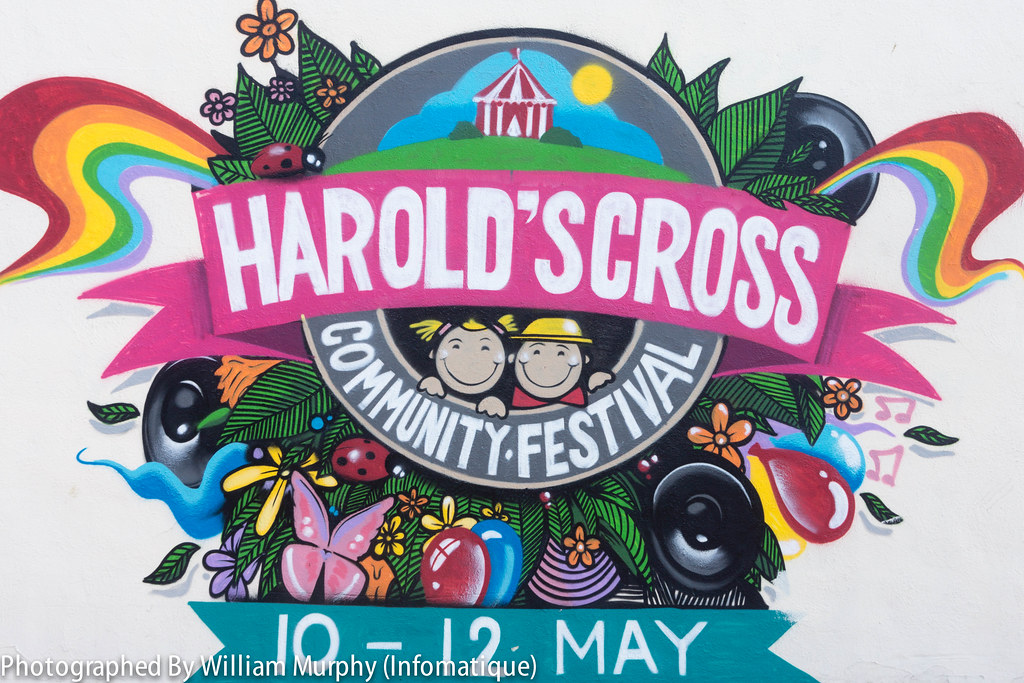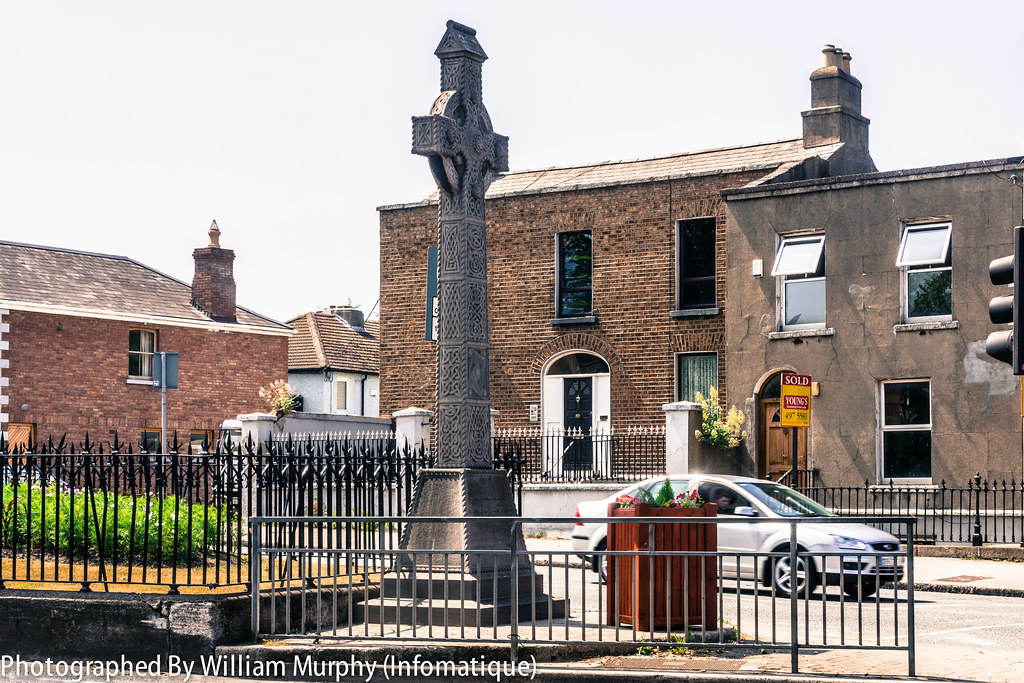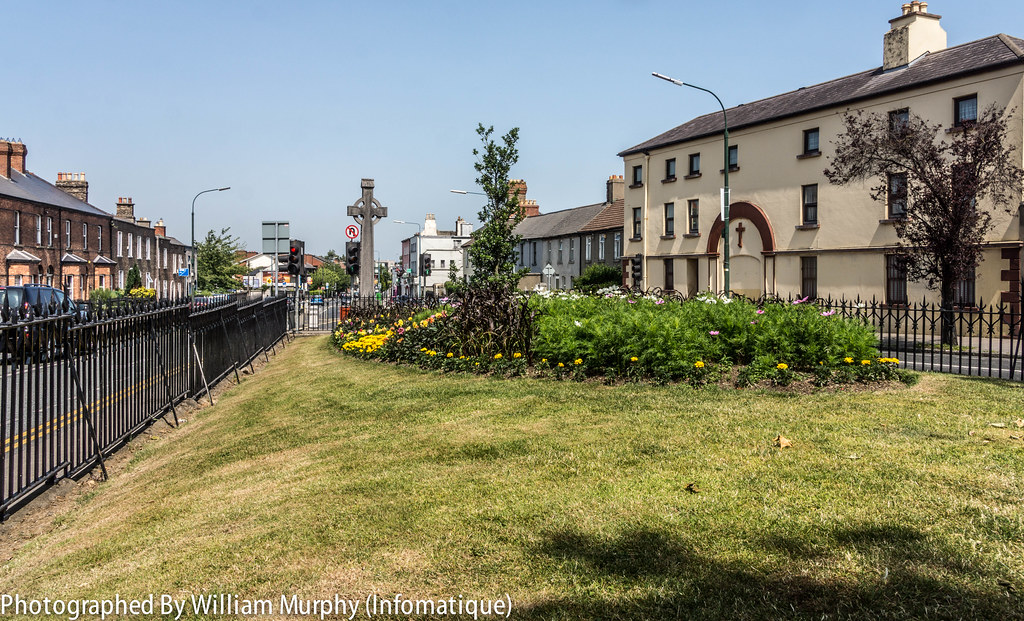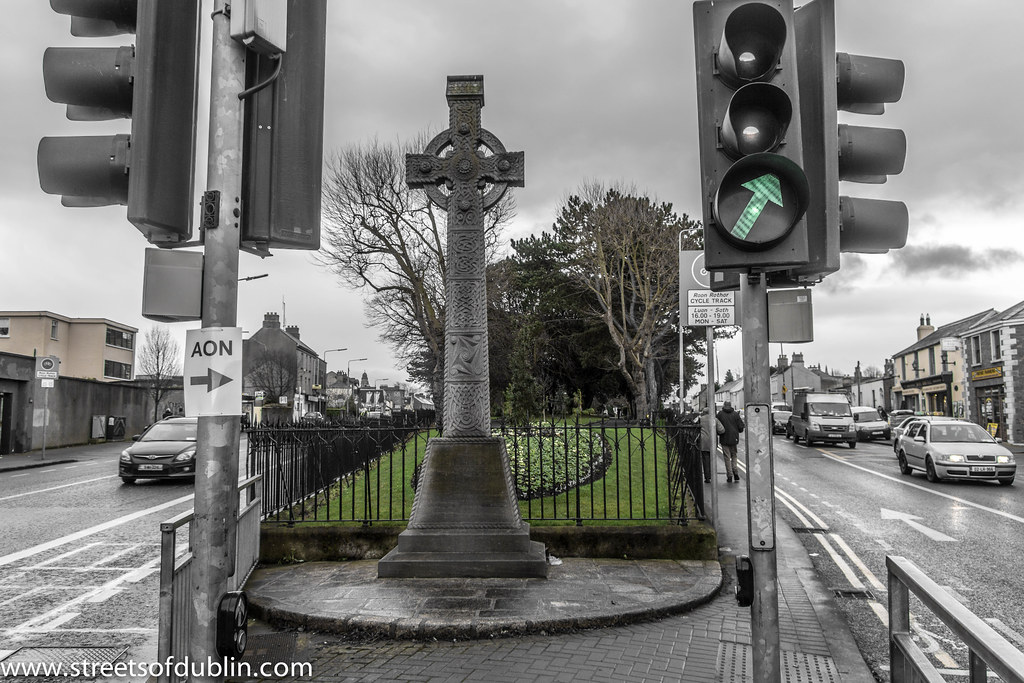HAROLD’S CROSS
Harold's Cross is an urban village and inner suburb on the south side of Dublin, Ireland.
Harold's Cross is situated north of Terenure and Rathgar, west of Rathmines, east of Crumlin and Kimmage, and directly south from the Grand Canal at Clanbrassil Street. It lies within the jurisdiction of Dublin City Council, and straddles the boundary of Dublin 6, Dublin 6W and Dublin 12 postal districts.
One explanation of the origin of the name Harold's Cross is that it is derived from the name given to a gallows, which had been placed where the current Harold's Cross Park is situated. Harold's Cross was an execution ground for the city of Dublin during the 18th century and earlier. In the 14th century the gallows there was maintained by the Archbishop.
Harold's Cross stands on lands which formed, like those of Rathmines, part of the Manor of St. Sepulchre, and its name is said to have originated in a cross which marked the boundary of the lands of the Archbishop of Dublin, and warned the Harolds, the wild guardians of the border of the Pale near Whitechurch that they must not encroach. The De Meones family, who gave their name to Rathmines, also owned lands at Harold's Cross in the fourteenth century.
Another explanation is that it is derived from a stone cross that marked the boundary of lands held by the Danish Viking Harold family of Rathfarnham in early medieval times, reputedly located at what is now the five-road Kenilworth junction on Harold's Cross Road.
Harold's Cross has a number of cafes, bars, shops, businesses and an active credit union. Harold's Cross Park, a small well maintained city park, occupies the site of the original village green.
Historically a number of large houses were constructed, mostly with the appendage of ‘Mount’, reflecting the parish's elevation, and their names are remembered today but no longer as houses: Mount Argus, (church and monastery) Mount Jerome (cemetery), Greenmount House (the Hospice), Mount Harold (the Catholic Church) and Mount Drummond and Mount Tallant (Housing).
At one side of Harold's Cross is Mount Jerome Cemetery, as mentioned in Joyce's Ulysses, originally the residence of a family named Shaw. It is considered Dublin's most gothic cemetery and there lie such lumunaries as Thomas Davis, George Russell (AE), and Oscar Wilde's father, William Wilde, and mother, in addition to members of the Guinness family and deceased members of the Royal Irish Constabulary. The remains of French Huguenots once buried in St. Peter's Churchyard, Peter's Row (now the location of the Dublin YMCA), which was demolished in the 1980s, are interred here. Other famous graves include those of mathematician William Rowan Hamilton and playwright John Millington Synge. The cemetery was operated from 1837 to 1984 by a private company and now belongs to the Massey family.
The suburb is also home to Dublin's first hospice, Our Lady's Hospice, Harold's Cross. This palliative care facility was founded in 1879 in a house called Our Lady's Mount (formerly Greenmount), which was previously the Mother House of the Religious Sisters of Charity. Mary Aikenhead, founder of the Sisters of Charity order, lived in Our Lady's Mount from 1845 onwards. She bought a large Georgian house at Greenmount from a famous abolitionist family called Webb who were members of the Society of Friends (Quakers), after she offered more than a rival bid from Mount Jerome cemetery. A new Hospice building was commenced in 1886, and many more buildings followed.
The memorial cross at Harolds Cross was sculpted by local Sculptor/stonemason Mr Joseph Courtney. His father, Patrick Courtney, was also a sculptor and worked on the internal altar and stone works of St. Augustine & St.John the Baptist or "John's Lane" in Thomas Street, Dublin 8. The tradition of sculptor / stonemason has continued on down through the Courtney generations at their premises 9 Thomas Street, Dublin 8 and later by the sons and grandsons at Francis Street, Dublin 8.
In 1804 the sisters of the order of St. Clare (San Damiano) moved to the village to run a female orphanage, founded the previous year, now the Saint Clare's Convent and Primary School. St. Clare's was founded in 1803 and as such is the oldest Catholic school in the Archdiocese of Dublin. Beside the convent is the national headquarters for the Secular Franciscan Order.
Harolds Cross is well served by public transport; Dublin Bus routes 9, 16, 18, 49, 54a and 83 (83A) pass through it. Dublin Bus also provides a Dublin Bus Nitelink service (49N) that operates the same route as the 49 on Friday, Saturday nights and on public holidays at 00:00, 02:00 and 04:00.
The area holds Saint Clare's Convent and Primary School, Scoil Malóga (Gaelscoil), Harold's Cross National School, Our Lady of the Rosary Roman Catholic church and Mount Argus Monastery and its church. Mount Argus was the official home of Saint Charles of Mount Argus who was a well known Passionist priest in 19th-century Ireland, he was mentioned as a miracle worker in the book Ulysses, Circe chapter. It also has long-established links with the Garda Síochána and it was officially the church of the Dublin Metropolitan Police.
The first Rector of Mount Argus was Fr. Paul Mary Pakenham who was the son of the Earl of Longford and nephew of Kitty Pakenham (Duchess of Wellington). His first mass took place in a house at the time on 15 August 1856. Irish architect J. J. McCarthy was commissioned to design the new monastery.
The former Church of Ireland parish church in Harold's Cross has been leased to the Moscow Patriarchate as Ss Peter and Paul Church, for the Russian Orthodox Church. A substantial congregation made up of Orthodox immigrants to Ireland (mostly from the former Soviet Union, Eastern Slovakia and Poland) along with native (mostly convert) Irish Orthodox attend services here. Services are conducted both in Church Slavonic and English with a smattering of Irish.
The Roman Catholic Parish Church in Harold's Cross is the Church of the Holy Rosary. The parish is an active one with many contributing to its attendant organisations. The church was built on top of the remains of an old stately house called Mount Harold house at the end of the 19th century. Original floor tiles of the house can still be seen on the chapel floor to this day.
Much of the local industry during the 19th century revolved around the old mills which were located on the River Poddle which passes through the area, with part of its flow diverted into the "City Watercourse" culvert at "The Tongue" or "Stone Boat". A paper mill was located at Mount Argus where there was a small rural village at that time, and also a flour mill was near the gates of Mount Jerome cemetery. At Mount Jerome the Poddle goes underground for much of the rest of its journey to the Liffey. During the 20th century the old mill at Mount Argus, disused at this stage, was adopted by the local Boy Scout troop the 45th Mount Argus as a boxing club, as a result of which the troop became commonly known as "the fighting 45th" troop in Dublin scouting circles. The troop was founded by Rev. Fr. Cronin C.P. of Mount Argus church.[15]
Harold's Cross Green was a key meeting point for members of the Society of United Irishmen just before the 1798 Rebellion, rebels such as Thomas Cloney and Myles Byrne meet the commander Robert Emmet to discuss tactics for pending uprising.
Irish Nationalist leader Robert Emmet was captured near Harold's Cross. He lived for a period in a house in Harold's Cross so he could be near his sweetheart Sarah Curran of Rathfarnham. He led an abortive rebellion against British rule in 1803 and was captured, tried and executed. The Grand Canal bridge linking Harold's Cross Road and Clanbrassil Street was named in his honour, where a plaque commemorates him (the bridge was formerly called Clanbrassil Bridge, and is known locally as Harold's Cross Bridge).
The father of Patrick Pearse (Pádraic Mac Piarais), James, was a stonemason for Mount Argus Church. The Pearse family had a long association with the Passionists and Mount Argus. Both Patrick and Willie Pearse came for confessions on the day of the Easter Rising. Mrs Pearse and Patrick himself also taught Irish language lessons in the community Scout hall next to the church. The 1916 Volunteers, who had a training ground in nearby Kimmage, are said to have paid a visit to Mount Argus Church to pray just before taking part in the 1916 Easter Rising.
O'Connor's Jewellers on Harold's Cross Road is noted for being the victim of one of the two famous robberies carried out by the notorious Dublin criminal Martin Cahill (who is also buried in Mount Jerome Cemetery).
Honour Bright, prostitute (real name Elizabeth (Lily) O'Neill) was murdered in June 1925, and her body found in the mountains. Witnesses last saw her alive at Leonards' Corner, just to the north of Harolds' Cross. Dr Patrick Purcell, a medical doctor in County Wicklow, and Leopold J. Dillon, a Garda, were put on trial charged with the murder, but were acquitted. The murderer was never traced.
There was a well-established community of Quakers in Harold's Cross that operated a number of industries in the locality including Cotton, paper and flour milling during the 19th century. They also ran a number of orphanages locally. Among these industries was the Greenmount Spinning manufacturing powered by the River Poddle, owned by the well-known Pim family. James Pim was commonly known as the "Quaker father of Irish railways.
Quaker brothers Thomas Pim and Robert Goodbody decided to relocate Goodbody Tabacco manufacturing to Greenville near Harolds Cross after a disastrous fire in their Tullamore premises in 1886; as a result most of their employees were also relocated to the area, where red brick terrace housing were built in the area by the Dublin Artizans' Dwellings Company, in which the Pim family were prominent members.
You will find links to buy products from Amazon, Google and other partners. If you click on these links, you’ll find that the URL includes a small extra piece of text which identifies that the click came from my websites. This text is an affiliate code, and it means that I get a small percentage of the money you spend if you choose to buy that product, or, in some cases, other products from the site soon after. These affiliate links help pay the costs of producing my websites and ensure that the content is free to you.
COPYRIGHT INFORMATION BELOW APPLIES ONLY TO PHOTOGRAPHS

This work by William Murphy aka Infomatique is licensed under a Creative Commons Attribution-NonCommercial-ShareAlike 4.0 International License.
Permissions beyond the scope of this license may be available at https://excellentstreetimages.com/in-the-year-twentytwenty/copyright/.














